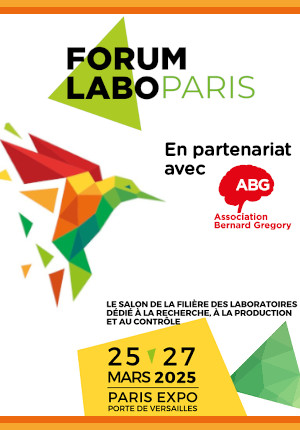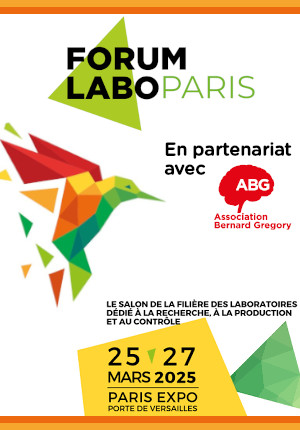L'origine et le développement des industries peu ouvragées en matière osseuse dans le Sud-ouest de la France. Apport de la microscopie corrélative et de la néotaphonomie pour l'interprétation fonctionnelle des plages de micro-usure // The origin and devel
|
ABG-128586
ADUM-60570 |
Thesis topic | |
| 2025-02-14 |
Université de Bordeaux
PESSAC Cedex - France
L'origine et le développement des industries peu ouvragées en matière osseuse dans le Sud-ouest de la France. Apport de la microscopie corrélative et de la néotaphonomie pour l'interprétation fonctionnelle des plages de micro-usure // The origin and devel
- Psychology, neurosciences
Pléistocène, Paléolithique moyen, Industrie osseuse, Microscope confocal, Archéologie expérimentale, Taphonomie expérimentale
Pleistocene, Middle Palaeolithic, Osseous technology, Confocal microscopy, Experimental archaeology, Experimental taphonomy
Pleistocene, Middle Palaeolithic, Osseous technology, Confocal microscopy, Experimental archaeology, Experimental taphonomy
Topic description
Lorsqu'ils discutent de l'origine et du développement des industries osseuses au cours du Pléistocène, la plupart des archéologues se focalisent sur les objets entièrement sculptés du Paléolithique récent européen et d'autres intègrent également les outils mis au jour en contexte Middle Stone Age africain. Or, l'utilisation de l'os à des fins technologiques est attestée par la présence d'outils expéditifs depuis plus de 2 millions d'année en Afrique du Sud (Backwell and d'Errico, 2008, 2001; d'Errico and Backwell, 2003; Hanon et al., 2021; Stammers et al., 2023, 2018; Val and Stratford, 2015), en Afrique de l'Est (Backwell and d'Errico, 2004; de la Torre et al., accepted; Pante et al., 2020) et en Asie orientale (pour une synthèse, voir Ma and Doyon, 2021). Ces outils sont d'ailleurs encore utilisés de nos jours par des populations porteuses de savoirs traditionnels. Quels ont été les grandes étapes du développement de ce pan technologique ? En quoi ces outils reflètent-ils des adaptations environnementales particulières ? Peut-on identifier des grandes tendances nous permettant d'aborder l'évolution des stratégies technologiques dans le temps ?
Au cours de la dernière décennie, un nombre croissant d'outils expéditifs a été documenté sur le continent européen (e.g., Baumann et al., 2023, 2022; Julien et al., 2015; Martisius et al., 2020; Mateo-Lomba et al., 2024; Romagnoli et al., 2016; Tartar, 2012; Tartar et al., 2022). Toutefois, les méthodes traditionnellement employées pour inférer le rôle de ces outils dans les systèmes technologiques préhistoriques sont qualitatives et peu reproductibles. Elles consistent principalement à comparer les usures présentes sur le matériel archéologique avec des corpus expérimentaux. Des études récentes soulignent les limites de ces approches, notamment le fait que le développement et la stabilisation des micro-usures fonctionnelles ne constituent pas un processus linéaire et sont déterminés en partie par la nature du matériel avec lequel l'outil en os a été en contact de façon prolongé d'une part (d'Errico et al., 2022; Martisius et al., 2018) et que des biais sont introduits par le choix de l'équipement et du facteur de grossissement pour l'identification des micro-usures d'autre part (Bradfield, 2022; Ma et al., 2023; Martisius, 2022; Mateo-Lomba et al., 2020). À cela s'ajoute également les nombreux processus taphonomique qui peuvent altérer, voire oblitérer, les traces d'utilisation et rendant la reconnaissance même de ces outils particulièrement difficile (Brain, 1981, 1967; Fernández-Jalvo and Andrews, 2016; Lyman, 1984). Il importe donc d'évaluer quantitativement l'apport de ces sources convergentes de variation pour affiner notre interprétation de ces vestiges et ainsi mieux saisir leur rôle dans les systèmes techniques des populations préhistoriques.
Le projet de thèse s'inscrit dans le prolongement des développements méthodologiques effectués à l'UMR5199 PACEA, notamment le recours à la tribologie (d'Errico et al., 2023, 2022; Doyon et al., 2023; Ma et al., 2023) et à l'analyse automatisée d'images (Courtenay et al., in press) pour faciliter l'identification et pour inférer la fonction des outils expéditifs. L'objectif de la thèse consistera à appliquer les principes de microscopie corrélative et de la néotaphonomie pour établir de manière complémentaire la fonction des outils préhistoriques et estimer la durée de leur utilisation. L'élaboration de corpus expérimentaux servira à la production d'un atlas de micro-usure. L'étude du matériel archéologique mis au jour à Artenac et La Quina (Charente) ainsi que Vaufrey Tourtoirac (Dordogne) permettra de tester la robustesse de la méthode.
Enfin, une attention particulière sera portée aux restes humains utilisés comme outils afin d'établir si les modifications qu'ils portent suggèrent des comportements symboliques qui diffèrent de la gestion des autres ressources animales à la disposition des groupes néandertaliens.
------------------------------------------------------------------------------------------------------------------------------------------------------------------------
------------------------------------------------------------------------------------------------------------------------------------------------------------------------
When discussing the origin and development of osseous technologies during the Pleistocene, most archaeologists focus on the fully carved objects of the European Upper Paleolithic, while others also include tools found in Middle Stone Age contexts in Africa. However, the use of bone for technological purposes is attested by the presence of expedient tools dating back over 2 million years in South Africa (Backwell and d'Errico, 2008, 2001; d'Errico and Backwell, 2003; Hanon et al., 2021; Stammers et al., 2023, 2018; Val and Stratford, 2015), East Africa (Backwell and d'Errico, 2004; de la Torre et al., accepted; Pante et al., 2020), and East Asia (for a review, see Ma and Doyon, 2021). Interestingly, these tools are still used today by bearers of traditional knowledge. What were the main tipping points in the development of this technological domain? How do these tools reflect specific environmental adaptations? Can we identify major trends that allow us to approach the evolution of technological strategies over time?
In the last decades, an increasing number of expedient tools have been documented in Europe (e.g., Baumann et al., 2023, 2022; Julien et al., 2015; Martisius et al., 2020; Mateo-Lomba et al., 2024; Romagnoli et al., 2016; Tartar, 2012; Tartar et al., 2022). However, the methods traditionally employed to infer the role of these tools in prehistoric technological systems are qualitative and often non-reproducible. They primarily consist of comparing wear patterns on archaeological material with experimental reference collections. Recent studies have highlighted the limitations of these approaches, particularly the fact that the development and stabilization of functional micro-wear are not linear processes which are determined in part by the nature of the material that was in prolonged contact with the bone tool (d'Errico et al., 2022; Martisius et al., 2018), and that biases are introduced by the choice of equipment and magnification factors used to identify micro-wear (Bradfield, 2022; Ma et al., 2023; Martisius, 2022; Mateo-Lomba et al., 2020). Additionally, numerous taphonomic processes can alter or even obliterate use-wear traces, making the identification of these tools particularly challenging (Brain, 1981, 1967; Fernández-Jalvo and Andrews, 2016; Lyman, 1984). Therefore, it is essential to quantitatively assess the contribution of these converging sources of variation to refine our interpretation of these remains and better understand their role in the technological systems of prehistoric populations.
This doctoral project builds upon the methodological advancements made at UMR5199 PACEA, particularly the use of tribology (d'Errico et al., 2023, 2022; Doyon et al., 2023; Ma et al., 2023) and automated image analysis (Courtenay et al., in press) to facilitate the identification and functional inference of expedient tools. The aim of the thesis will be to apply the principles of correlative microscopy and neo-taphonomy to complementarily determine the function of prehistoric tools and estimate the duration of their use. The creation of experimental reference collections will serve as the basis for producing a micro-wear atlas. The study of the archaeological material uncovered at Artenac and La Quina (Charente) as well as Vaufrey and Tourtoirac (Dordogne) will allow for testing the robustness of the method.
Finally, particular attention will be given to human remains used as tools to determine whether the modifications they bear suggest symbolic behaviors distinct from the management of other animal resources available to Neanderthal groups.
------------------------------------------------------------------------------------------------------------------------------------------------------------------------
------------------------------------------------------------------------------------------------------------------------------------------------------------------------
Début de la thèse : 01/10/2025
Au cours de la dernière décennie, un nombre croissant d'outils expéditifs a été documenté sur le continent européen (e.g., Baumann et al., 2023, 2022; Julien et al., 2015; Martisius et al., 2020; Mateo-Lomba et al., 2024; Romagnoli et al., 2016; Tartar, 2012; Tartar et al., 2022). Toutefois, les méthodes traditionnellement employées pour inférer le rôle de ces outils dans les systèmes technologiques préhistoriques sont qualitatives et peu reproductibles. Elles consistent principalement à comparer les usures présentes sur le matériel archéologique avec des corpus expérimentaux. Des études récentes soulignent les limites de ces approches, notamment le fait que le développement et la stabilisation des micro-usures fonctionnelles ne constituent pas un processus linéaire et sont déterminés en partie par la nature du matériel avec lequel l'outil en os a été en contact de façon prolongé d'une part (d'Errico et al., 2022; Martisius et al., 2018) et que des biais sont introduits par le choix de l'équipement et du facteur de grossissement pour l'identification des micro-usures d'autre part (Bradfield, 2022; Ma et al., 2023; Martisius, 2022; Mateo-Lomba et al., 2020). À cela s'ajoute également les nombreux processus taphonomique qui peuvent altérer, voire oblitérer, les traces d'utilisation et rendant la reconnaissance même de ces outils particulièrement difficile (Brain, 1981, 1967; Fernández-Jalvo and Andrews, 2016; Lyman, 1984). Il importe donc d'évaluer quantitativement l'apport de ces sources convergentes de variation pour affiner notre interprétation de ces vestiges et ainsi mieux saisir leur rôle dans les systèmes techniques des populations préhistoriques.
Le projet de thèse s'inscrit dans le prolongement des développements méthodologiques effectués à l'UMR5199 PACEA, notamment le recours à la tribologie (d'Errico et al., 2023, 2022; Doyon et al., 2023; Ma et al., 2023) et à l'analyse automatisée d'images (Courtenay et al., in press) pour faciliter l'identification et pour inférer la fonction des outils expéditifs. L'objectif de la thèse consistera à appliquer les principes de microscopie corrélative et de la néotaphonomie pour établir de manière complémentaire la fonction des outils préhistoriques et estimer la durée de leur utilisation. L'élaboration de corpus expérimentaux servira à la production d'un atlas de micro-usure. L'étude du matériel archéologique mis au jour à Artenac et La Quina (Charente) ainsi que Vaufrey Tourtoirac (Dordogne) permettra de tester la robustesse de la méthode.
Enfin, une attention particulière sera portée aux restes humains utilisés comme outils afin d'établir si les modifications qu'ils portent suggèrent des comportements symboliques qui diffèrent de la gestion des autres ressources animales à la disposition des groupes néandertaliens.
------------------------------------------------------------------------------------------------------------------------------------------------------------------------
------------------------------------------------------------------------------------------------------------------------------------------------------------------------
When discussing the origin and development of osseous technologies during the Pleistocene, most archaeologists focus on the fully carved objects of the European Upper Paleolithic, while others also include tools found in Middle Stone Age contexts in Africa. However, the use of bone for technological purposes is attested by the presence of expedient tools dating back over 2 million years in South Africa (Backwell and d'Errico, 2008, 2001; d'Errico and Backwell, 2003; Hanon et al., 2021; Stammers et al., 2023, 2018; Val and Stratford, 2015), East Africa (Backwell and d'Errico, 2004; de la Torre et al., accepted; Pante et al., 2020), and East Asia (for a review, see Ma and Doyon, 2021). Interestingly, these tools are still used today by bearers of traditional knowledge. What were the main tipping points in the development of this technological domain? How do these tools reflect specific environmental adaptations? Can we identify major trends that allow us to approach the evolution of technological strategies over time?
In the last decades, an increasing number of expedient tools have been documented in Europe (e.g., Baumann et al., 2023, 2022; Julien et al., 2015; Martisius et al., 2020; Mateo-Lomba et al., 2024; Romagnoli et al., 2016; Tartar, 2012; Tartar et al., 2022). However, the methods traditionally employed to infer the role of these tools in prehistoric technological systems are qualitative and often non-reproducible. They primarily consist of comparing wear patterns on archaeological material with experimental reference collections. Recent studies have highlighted the limitations of these approaches, particularly the fact that the development and stabilization of functional micro-wear are not linear processes which are determined in part by the nature of the material that was in prolonged contact with the bone tool (d'Errico et al., 2022; Martisius et al., 2018), and that biases are introduced by the choice of equipment and magnification factors used to identify micro-wear (Bradfield, 2022; Ma et al., 2023; Martisius, 2022; Mateo-Lomba et al., 2020). Additionally, numerous taphonomic processes can alter or even obliterate use-wear traces, making the identification of these tools particularly challenging (Brain, 1981, 1967; Fernández-Jalvo and Andrews, 2016; Lyman, 1984). Therefore, it is essential to quantitatively assess the contribution of these converging sources of variation to refine our interpretation of these remains and better understand their role in the technological systems of prehistoric populations.
This doctoral project builds upon the methodological advancements made at UMR5199 PACEA, particularly the use of tribology (d'Errico et al., 2023, 2022; Doyon et al., 2023; Ma et al., 2023) and automated image analysis (Courtenay et al., in press) to facilitate the identification and functional inference of expedient tools. The aim of the thesis will be to apply the principles of correlative microscopy and neo-taphonomy to complementarily determine the function of prehistoric tools and estimate the duration of their use. The creation of experimental reference collections will serve as the basis for producing a micro-wear atlas. The study of the archaeological material uncovered at Artenac and La Quina (Charente) as well as Vaufrey and Tourtoirac (Dordogne) will allow for testing the robustness of the method.
Finally, particular attention will be given to human remains used as tools to determine whether the modifications they bear suggest symbolic behaviors distinct from the management of other animal resources available to Neanderthal groups.
------------------------------------------------------------------------------------------------------------------------------------------------------------------------
------------------------------------------------------------------------------------------------------------------------------------------------------------------------
Début de la thèse : 01/10/2025
Funding category
Funding further details
Appel à projets - UB PhD Scholarships
Presentation of host institution and host laboratory
Université de Bordeaux
Institution awarding doctoral degree
Université de Bordeaux
Graduate school
304 Sciences et environnements
Candidate's profile
Connaissance en Préhistoire européenne (particulièrement du Paléolithique moyen); expérience en analyse de culture matérielle préhistorique; connaissances en anthropologie et archéozoologie souhaitées,
Sont éligibles uniquement des candidatures internationales, à savoir :
- des candidates ou candidats ayant obtenu (ou en cours d'obtention de) leur diplôme d'accès au doctorat (Master ou équivalent) dans un établissement à l'étranger
- des candidates ou candidats actuellement dans un Graduate Program de l'université de Bordeaux, inscrits en deuxième année de Master et ayant obtenu leur diplôme d'accès au Master dans un établissement à l'étranger
Seront prises en compte uniquement les candidatures soumises sur la plateforme suivante : https://aap.u-bordeaux.fr/ et avant le 17 mars à 23h59 (GMT Paris).
Un guide de candidature ainsi que la liste des documents à soumettre sont disponibles sur la plateforme.
Pour toute question, veuillez contacter : internationalisation.doctorat@u-bordeaux.fr
Interest in European Prehistory, particularly the Middle Palaeolithic; experience in the analysis of prehistoric material culture; knowledge in biological anthropology and zooarchaeology is a plus. The UB PhD scholarship program is open to international candidates only, which means: - candidates holding (or currently enrolled in) a national level master's degree or another degree conferring master's status from a foreign institution - candidates currently in a Graduate Program, enrolled in second year of Master at the University of Bordeaux, and holding a degree from a foreign institution We will only consider applications submitted on the following platform: https://aap.u-bordeaux.fr/ and prior March 17, at 11:59pm (GMT Paris). A guide on how to apply as well as the list of documents to submit are available on the platform. For any question, please contact: internationalisation.doctorat@u-bordeaux.fr
Interest in European Prehistory, particularly the Middle Palaeolithic; experience in the analysis of prehistoric material culture; knowledge in biological anthropology and zooarchaeology is a plus. The UB PhD scholarship program is open to international candidates only, which means: - candidates holding (or currently enrolled in) a national level master's degree or another degree conferring master's status from a foreign institution - candidates currently in a Graduate Program, enrolled in second year of Master at the University of Bordeaux, and holding a degree from a foreign institution We will only consider applications submitted on the following platform: https://aap.u-bordeaux.fr/ and prior March 17, at 11:59pm (GMT Paris). A guide on how to apply as well as the list of documents to submit are available on the platform. For any question, please contact: internationalisation.doctorat@u-bordeaux.fr
2025-03-17
Apply
Close
Vous avez déjà un compte ?
Nouvel utilisateur ?
More information about ABG?
Get ABG’s monthly newsletters including news, job offers, grants & fellowships and a selection of relevant events…
Discover our members
 Aérocentre, Pôle d'excellence régional
Aérocentre, Pôle d'excellence régional  MabDesign
MabDesign  CESI
CESI  ADEME
ADEME  Ifremer
Ifremer  SUEZ
SUEZ  Laboratoire National de Métrologie et d'Essais - LNE
Laboratoire National de Métrologie et d'Essais - LNE  Groupe AFNOR - Association française de normalisation
Groupe AFNOR - Association française de normalisation  CASDEN
CASDEN  MabDesign
MabDesign  Nokia Bell Labs France
Nokia Bell Labs France  ANRT
ANRT  Tecknowmetrix
Tecknowmetrix  Institut de Radioprotection et de Sureté Nucléaire - IRSN - Siège
Institut de Radioprotection et de Sureté Nucléaire - IRSN - Siège  Institut Sup'biotech de Paris
Institut Sup'biotech de Paris  TotalEnergies
TotalEnergies  ONERA - The French Aerospace Lab
ONERA - The French Aerospace Lab  PhDOOC
PhDOOC  Généthon
Généthon










